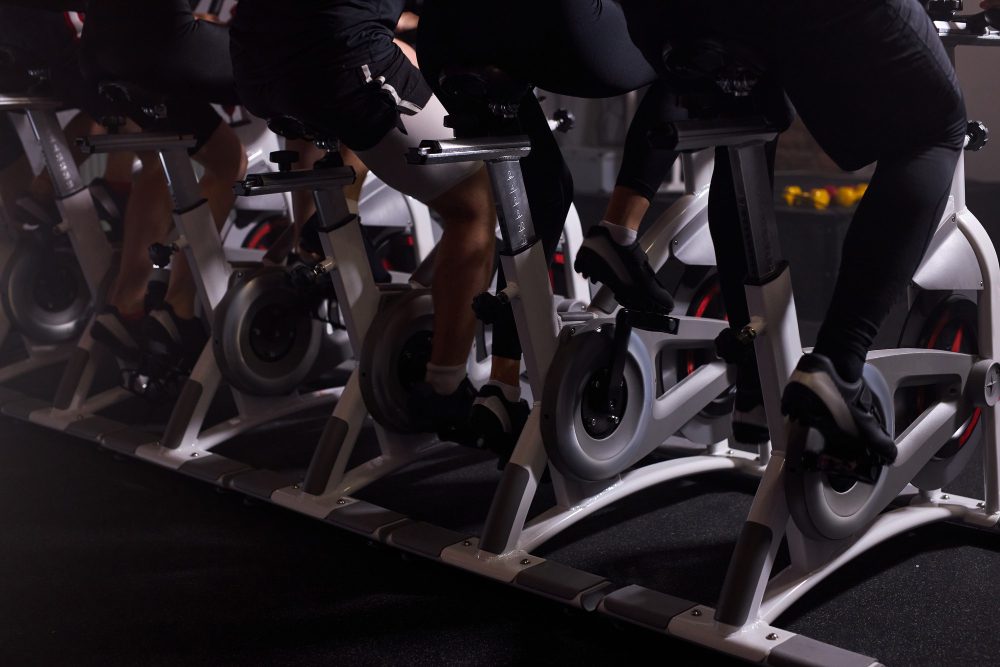Should I get an upright bike or spin bike?
If you’re in the market for a new exercise bike, you may be wondering whether to go for an upright bike or a spin bike. Both options have their own unique features and benefits, so it’s important to consider your personal fitness goals and preferences before making a decision.
The Differences Between Upright Bikes and Spin Bikes
Upright bikes are designed to replicate the feel of riding a traditional bicycle. They feature a comfortable, saddle-style seat and handlebars that are positioned higher than the seat. Upright bikes also typically have a more relaxed riding position, making them suitable for individuals of all fitness levels.
Spin bikes, on the other hand, are designed to mimic the experience of cycling in a studio class. These bikes feature a more aggressive riding position with forward-leaning handlebars and a saddle that closely resembles a racing bike seat. Spin bikes also offer a heavier flywheel and a range of resistance levels to simulate different terrains and intensities.
Choosing the Right Bike for You
When deciding between an upright bike and a spin bike, it’s essential to consider your fitness goals and exercise preferences. Here are some factors to keep in mind:
- Intensity: If you enjoy high-intensity workouts and want to replicate the experience of a spin class, a spin bike may be the better option. With its more aggressive riding position and adjustable resistance levels, a spin bike allows for more intense workouts.
- Comfort: If you prioritize comfort and prefer a more relaxed riding position, an upright bike might be the right choice. The upright design offers a more comfortable seat and a riding position that is easier on your back and joints.
- Space: Consider the space you have available for your exercise equipment. Upright bikes typically have a smaller footprint and are more space-friendly, making them suitable for smaller homes or apartments.
- Budget: Spin bikes, especially those with advanced features like digital displays and programmable workouts, tend to be pricier than upright bikes. Determine your budget and choose a bike that offers the features you need within your price range.
Ultimately, the decision between an upright bike and a spin bike comes down to your personal fitness goals, preferences, and budget.
Key Takeaways
In summary, here are the key takeaways when considering an upright bike versus a spin bike:
- Upright bikes offer a more relaxed riding position, suitable for individuals of all fitness levels.
- Spin bikes provide a more intense workout experience, simulating the feel of a spin class.
- Consider factors such as intensity, comfort, space, and budget when making a decision.
Ultimately, the choice between an upright bike and a spin bike depends on your unique needs and preferences. Whichever option you choose, regular exercise on a bike can contribute to improved cardiovascular health, enhanced endurance, and increased overall fitness.
Is it OK to sit upright on a spin bike?
When it comes to choosing between an upright bike and a spin bike, one common question that arises is whether it is acceptable to sit upright on a spin bike. The answer to this question depends on various factors, including personal preference and fitness goals.
Understanding the Difference
Before we delve into the topic, let’s quickly differentiate between an upright bike and a spin bike. An upright bike resembles a traditional bicycle, with a seat positioned directly above the pedals. On the other hand, a spin bike is designed to mimic the experience of cycling outdoors and typically features a more streamlined frame, handlebars positioned lower than the seat, and pedals with toe cages or clip-in options.
Comfort vs. Intensity
One of the main reasons people prefer an upright bike is the comfort it provides. The upright position allows for a more relaxed and ergonomic riding experience, making it ideal for individuals with joint issues or back problems. However, it’s worth noting that sitting upright on a spin bike can reduce the intensity of your workout.
If your primary goal is to engage in high-intensity interval training (HIIT) or simulate outdoor cycling, sitting upright may not give you the same level of intensity as when you adopt a more leaned-forward position common in spin classes. The forward-leaning position on a spin bike engages your core, works your upper body, and allows you to generate more power during your rides.
Personalizing Your Workout
Ultimately, the choice between sitting upright or adopting a more forward-leaning position on a spin bike depends on your personal preference and fitness goals. If you’re looking for a comfortable cardiovascular workout or are recovering from an injury, sitting upright can be a suitable option. However, if you want to challenge yourself and maximize your calorie burn, leaning forward on a spin bike will help you achieve those goals.
Remember, it’s crucial to listen to your body and make adjustments as needed. If you’re new to indoor cycling or have any concerns, consult a fitness professional who can guide you on proper form and technique.
What are the disadvantages of spin bike?
A spin bike is an indoor exercise bike designed to simulate outdoor cycling. While it offers a high-intensity cardiovascular workout and many benefits, there are also some disadvantages to consider before purchasing one:
1. Limited Adjustability
Spin bikes often have limited adjustability options compared to other types of exercise bikes. This can be a problem for individuals with specific height or body type requirements, as it may lead to discomfort or improper alignment during workouts.
2. Lack of Comfort
Spin bikes generally have a firmer seat and a more aggressive riding position compared to upright bikes. This can result in less comfort, especially for those who are new to cycling or have existing back or joint issues.
3. Potential Knee Strain
The intense nature of spin bike workouts, particularly when performed at high resistance levels or with improper form, can put strain on the knees. This can be a concern for individuals with knee injuries or conditions such as arthritis.
4. No Pre-Programmed Workouts
Unlike some modern upright bikes, spin bikes typically do not come with pre-programmed workout routines or interactive features. This means you’ll need to create your own routines or rely on external sources for guidance and variety in your workouts.
5. Higher Price Range
Spin bikes tend to be more expensive compared to basic upright bikes, which may deter some budget-conscious individuals. However, it’s important to consider the quality and durability of the bike before making a purchasing decision.
6. Not Suitable for Everyone
Spin bikes are specifically designed for intense cardio workouts and may not be suitable for everyone. Individuals with certain health conditions or physical limitations should consult a healthcare professional before engaging in high-intensity exercise.
7. Lack of Entertainment Features
Most spin bikes focus solely on the workout experience and do not include built-in entertainment features, such as a tablet holder or Bluetooth connectivity. This may be a drawback for individuals who enjoy multitasking or using digital entertainment during their workouts.
8. Noisy Operation
Spin bikes can sometimes generate more noise compared to other types of exercise bikes, especially if the bike has a chain drive system. This may be an issue for those who prefer a quieter exercise environment.
9. Limited Storage Options
Spin bikes are often larger and heavier than upright bikes, making them less practical for individuals with limited space or those who need to frequently store or transport their exercise equipment.
10. Intense Workout Experience
While this can be an advantage for some, the intense nature of spin bike workouts may not be suitable for individuals who prefer a more relaxed or low-impact exercise routine.
In conclusion, spin bikes offer a challenging cardiovascular workout, but they also have some drawbacks to consider. It’s essential to assess your specific needs, preferences, and limitations before deciding whether a spin bike is the right choice for you.
Are at home spin bikes worth it?
Spin bikes, also known as indoor cycling bikes, have become increasingly popular for those looking to get a high-intensity cardio workout from the comfort of their own homes. But are they really worth the investment?
Benefits of at home spin bikes
There are several benefits to having a spin bike at home. Firstly, they provide a convenient and accessible way to exercise. With a spin bike in your own home, you can work out whenever it suits you, without having to worry about travel time or gym opening hours.
Secondly, spin bikes offer a highly effective cardiovascular workout. The intense nature of spinning allows you to burn calories and improve your fitness levels in a short amount of time. Additionally, spin bikes typically come with adjustable resistance levels, allowing you to tailor the intensity of your workout to your own fitness level.
Considerations before purchasing
Before investing in an at home spin bike, there are a few things to consider. Firstly, it’s important to think about your motivation and commitment to regular exercise. While having a spin bike at home can be convenient, it’s essential to ensure you will actually use it regularly to make the purchase worthwhile.
Another consideration is the space available in your home. Spin bikes can take up a significant amount of room, so make sure you have enough space to accommodate the bike and allow for comfortable exercising.
Cost comparison
When comparing the cost of an at home spin bike to a gym membership or attending classes, spin bikes can be a more cost-effective option in the long run. While the upfront cost may be higher, owning a spin bike eliminates the need for monthly gym fees or class fees, ultimately saving you money over time.
Final thoughts
“Investing in an at home spin bike can be a great way to stay fit and motivated, as long as you are committed to using it regularly.”
In conclusion, if you are dedicated to regular exercise and have the space available in your home, an at home spin bike can be a valuable investment. The convenience, effectiveness, and potential cost savings make it a worthwhile choice for those looking to stay fit and active from the comfort of their own homes.
Conclusion
So, is it okay to sit upright on a spin bike? The answer is yes, but it may affect the intensity of your workout. Consider your goals, comfort level, and consult with professionals to find the best position that suits your needs. Both sitting upright and adopting a forward-leaning position have their benefits, so choose what works best for you and enjoy your ride!



